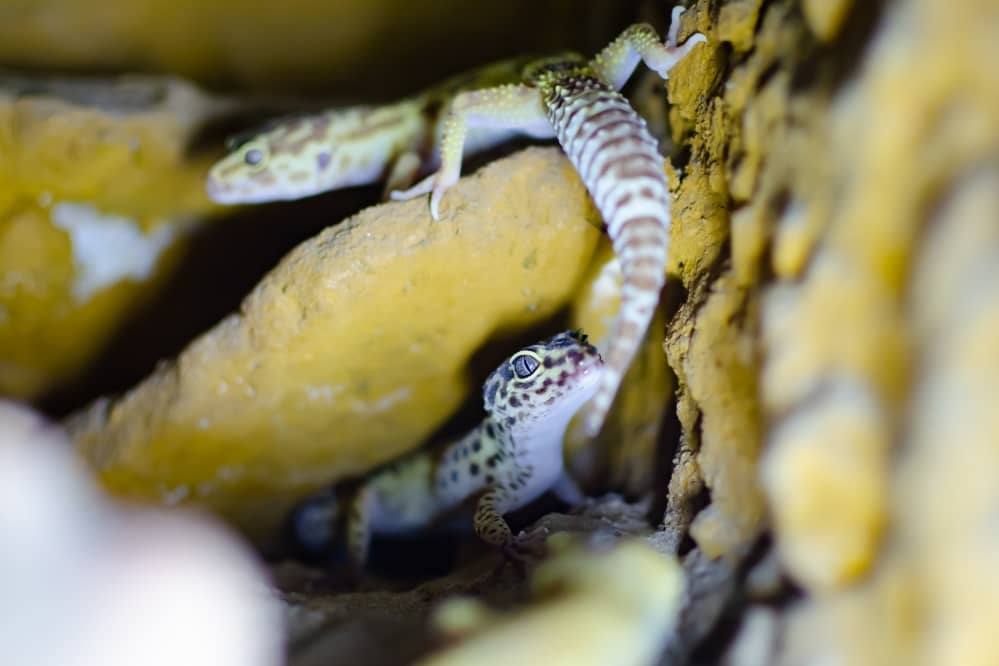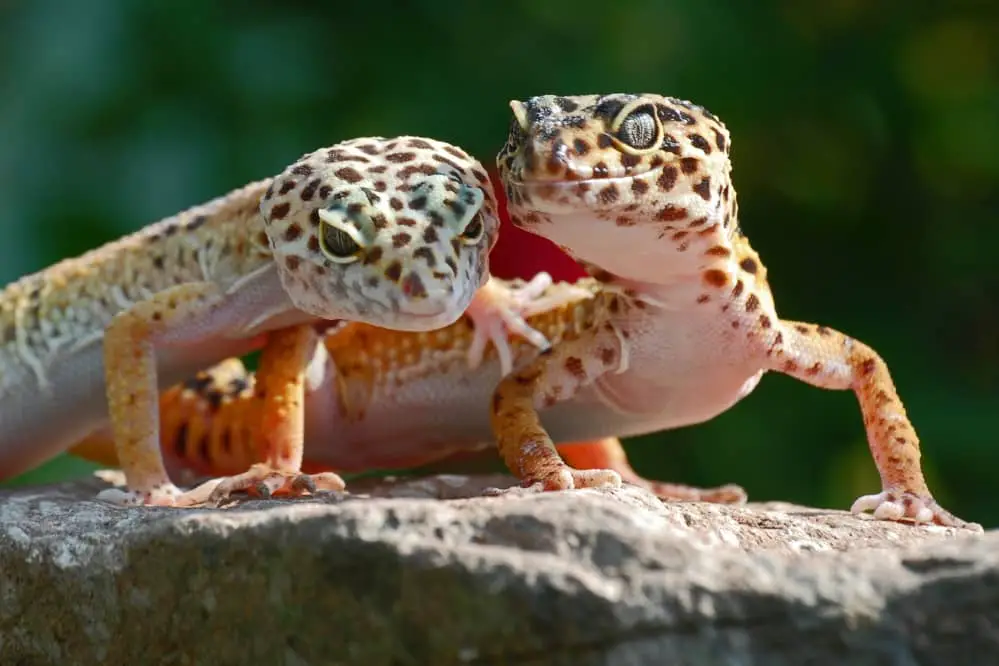Leopard geckos are one of the easiest reptiles to care for, so many people who keep them decide they want another. But is it a good idea to keep two leopard geckos in the same tank?
Leopard geckos are solitary by nature and tend to be territorial, so it’s rarely a good idea for them to live together. Female leopard geckos can live together, but it’s not uncommon for male leopards to fight each together—sometimes fatally. In general, it’s better not to keep leopard geckos together in the same tank.
Although cohabiting two females may be possible in some instances, it should be avoided. Let’s examine the issues involved with housing Leopard Geckos together.
What challenges do leopard geckos face living together?
The cohabitation of male leopard geckos
They will likely fight when two or more leopard geckos are kept in the same tank. Male leopard geckos are naturally territorial and aggressive, especially when they reach adulthood. Each will likely perceive the other as a threat and launch an attack. This can result in tail loss and other injuries.
Female leopard geckos cohabiting
While maintaining multiple female leopard geckos together is safer than keeping numerous males, there are risks involved. For starters, if one female leopard gecko is significantly larger than the other, she may attempt to dominate them. If the tank is too tiny or lacks good hiding areas, it can compel geckos to become agitated and begin fighting.
Male and female leopard geckos living together
It would help if you placed male and female specimens only for breeding leopard geckos. Failure to do so will result in the unnecessary laying of fertilized eggs. Since this is a strenuous activity, allowing it to occur often without a strategy will eventually shorten the life of your female leopard gecko. To breed leopard geckos, you should keep one male with multiple females. This guarantees that more eggs are fertilized and lessens the stress placed on each female leopard gecko.
What is the best tank size for holding several leopard geckos?
A 20-gallon tank is enough space for one leopard gecko but not several. Forcing them to live in such a small space can result in problems like:
- Shedding
- Continuous pacing
- Aggression
- Stunted growth
You should not put more than two leopard geckos in a cage together—otherwise, they won’t be able to find their own space if they feel stressed out.
Another significant drawback to extra-large aquariums is that leopard geckos often have difficulty finding their food, hides, and other spots when placed in such tanks.
Additional things to keep in mind when putting two leopard geckos together
While gender is commonly believed to be the most important aspect, it is not the only one, so let’s examine some others.
1. History and Relationship
Female leopard geckos raised together from birth are more likely to get along, but only in comparison to adult leopard geckos that have never met. The fact that they were raised together doesn’t matter when it comes to male leopard geckos. Clutch mates are still prone to fight when placed in the same enclosure.
2. Size of the Enclosure and Resource Availability
Creating a single leopard gecko habitat is considerably simpler than creating a habitat for two leopard geckos. Not only do you need significantly more space, you must also carefully balance available resources.
This includes providing numerous spaces for hiding, basking, staying cool, eating, etc. Remember that leopard geckos, being asocial organisms, are naturally competitive, and you should limit possibilities for resource battles. This necessitates ample supplies for each leopard gecko.
3. Leopard Geckos Size
Even if they appear amicable, leopard geckos will have to compete for resources, at least to some level. If one leopard gecko is substantially larger than the other, it is straightforward to predict how the competition will conclude, and one leopard gecko will typically obtain more food. As a result of their reduced size, certain leopard geckos may be marginally better at catching crickets. If you were to attempt cohabitation (which is not advised), you would also need to ensure that each leopard gecko is of comparable size.
Age and Sexual Maturity
Like many other reptiles, leopard geckos reach sexual maturity depending on weight rather than age. Typically, sexual maturity develops between 18 and 24 months or roughly 35 grams. As juveniles, leopard geckos may get along well with one another, but after they reach sexual maturity, their interactions may shift drastically due to fluctuating hormone levels. As they search for a partner, leopard geckos may become more territorial.
Therefore, the fact that juvenile leopard geckos get along does not imply that this will continue until they reach sexual maturity, which is guaranteed to generate problems in the case of males
Frequently Asked Questions

Can a juvenile leopard gecko live with an adult?
This is typically the worst possible pairing, as an adult leopard gecko may attempt to consume a juvenile leopard gecko. Leopard geckos are not social and lack intelligence; therefore, they will frequently try to consume anything, including a young leopard. Pairing two infants is possible, but not an infant and an adult leopard gecko
Can two leopard geckos be kept together?
Certain keepers have been able to house two female leopard geckos, but it’s not worth the bother or worries because you’ll still need a large cage. Men should never be kept with females unless they desire babies, and males should never be housed with other males.
Can three leopard geckos live together?
Three leopard geckos in the same cage is an even worse idea than placing two leopard geckos in the same enclosure. More leopard geckos increase the likelihood of conflict, necessitate additional space, and prohibit you from monitoring the appetite and excretion of each leopard gecko.
Will two female leopard geckos fight?
Female leopard geckos are the least likely of all gender combinations to fight, but that does not mean it never occurs. Unlike pairing two males, which is nearly certain to result in a confrontation, several keepers have successfully matched females, although this is not a recommended practice.
Conclusion
Do not house more than one leopard gecko together unless you want them to breed. However, it’s safer to house female geckos together if you must. But even then, know that problems may arise—especially if one of the female is in heat. Ensure that the geckos you pair up are healthy and have enough space in their tank. This will help keep them from fighting each other and contribute to overall good health.

